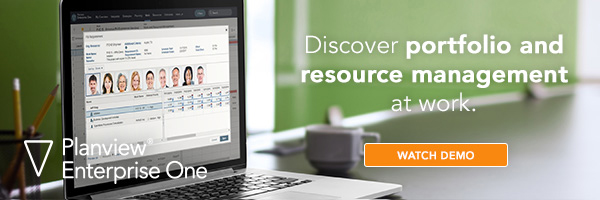
Digital disruption is everywhere. It has infiltrated not only the ways in which people work, how organizations deliver products, and what is required to remain competitive in today’s market, but it has also vastly altered customer expectations and demands. Gone are the days in which customers merely anticipated the next product release—those days have been replaced with customer demands for connected, digital experiences. These demands are what push businesses to execute at hyper-speed.
In the final part of the “Your PMO at Hyper-speed” workshop series, we will examine how operating at hyper-speed is all about moving beyond projects and will present three simple steps on just how to launch your organization’s PMO into action. Want to catch up on the previous four blogs and webcasts? Browse through the list below before we get started:
- Part 1: Shift from Annual to Continuous Planning to Enable Agility
- Part 2: Fuel Decisions with Data by Making the PMO a Strategic Partner
- Part 3: Project Management Software to Boost Your PMO into Hyper-speed
- Part 4: 4 Steps to Effectively Execute on Strategy
Digital transformation goes beyond people and work.
With everything connected, digital transformation brings technology into the picture to deliver the experiences consumers expect. It requires organizations to move beyond projects to define what the business or customers will be able to do better, create a proper “definition of success,” connect strategy and delivery to ensure value for investments and understand resource needs and usage, and focus on providing outcomes/changes needed across the organization to achieve strategic business goals. That may seem like a lot, but it can all be achieved through an integrated, top-down roadmap—one that is connected to outcomes and delivery.
What is an integrated portfolio?
Essentially, it is an opportunity for project managers to act, not only as implementers, but as internal consultants. Their role is expanding, and an integrated portfolio equips them with critical knowledge of digital disruptions. No longer is their task to solely deliver a project, but rather to first determine what products should be delivered to the organization based on available technologies. Through an integrated portfolio, they gain the ability to then create a feasible plan that will allow them to handle the disruptions from technology and stay align with, if not ahead, of the change.
What does that mean to the PMO?
IT projects have changed. They are no longer the monolithic applications of the past that required detailed schedules. Rather, with the introduction of new technologies, the PMO doesn’t have to know the outcome of a project right from the beginning—they can adapt as changes occur. Of course, this doesn’t come without its challenges. With digital transformation, the PMO faces the challenges of:
- Ambiguity, such as with market shifts and changing priorities;
- Constant change through fluid requirements, dynamic scope, and continuous adjustments; and
- Disruptive technology that requires new skill sets and new digital business models.
These challenges aren’t small, but they can be easily overcome through three simple steps to ensure your PMO is ready to take on the challenges of digital transformation.
Three steps to boost your PMO into hyper-speed.
- Look beyond projects.
Stop thinking like traditional project managers and start thinking like a product or program manager to break free of project silos. This means holistically managing the customer experience from a broader perspective, specifically looking to:
- Identify measurable outcomes and define what success looks like;
- Collaborate with enterprise and/or business architects;
- Embrace ideation and analysis around technology; and
- Include technology and application lifecycles in high level plans.
- Manage change.
Change is inevitable. What matters is how we deal with it. To deliver value more often, embrace and successfully manage change, and be able to consider technology impacts early and often, you must stop:
- Creating complex project schedules based off detailed requirements
- Thinking you must deliver a perfect solution
- Getting mired in the unknown
Instead, start:
- Embracing uncertainty
- Leveraging portfolio management to plan strategic initiatives
- Identifying the business capabilities that will be impacted
- Breaking down strategic initiatives to execute iteratively
- Deliver results.
Rather than executing IT projects with long timelines and a “once and done” mindset, create roadmaps that include:
- Strategic goals and desired outcomes;
- Measurable objectives over time;
- Technology and application lifecycles; and
- Uncertainty!
By embracing these elements and allowing them to guide your projects, your organization will have the capability to create processes that enable you to measure the progress of objectives over time and react as priorities shift—both crucial and necessary abilities in the world of digital transformation. Your organization and, specifically, the PMO, must plan and have the ability to adapt with technology.
Think about how you’re currently managing projects within your organization. What are your project managers spending most of their time on? How are they planning their projects? Is the PMO enabling and even challenging their project managers to think outside the box and navigate the constant impact and change of technology? Planview can help you improve your answers to these questions. Check out how our solutions can boost your PMO into hyper-speed by visiting www.planview.com, and for more information, register for the full webinar, “Digital Transformation at Hyper-speed: Maximize Your Technology, Applications, and Data.” Technology may make things seems difficult and unknown, but once your PMO adopts the new skill sets and digital business models necessary for digital transformation, your organization will be on its way to delivering more successful projects.


![Fuel Decisions with Data by Making the PMO a Strategic Partner [Webinar]](https://blog.planview.com/wp-content/uploads/2018/09/Fuel-Decisions-with-Data-by-Making-the-PMO-a-Strategic-Partner.jpg)
![Shift from Annual to Continuous Planning to Enable Agility [Webinar]](https://blog.planview.com/wp-content/uploads/2018/08/Shift-from-Annual-to-Continuous-Planning-to-Enable-Agility-Webinar.jpg)


